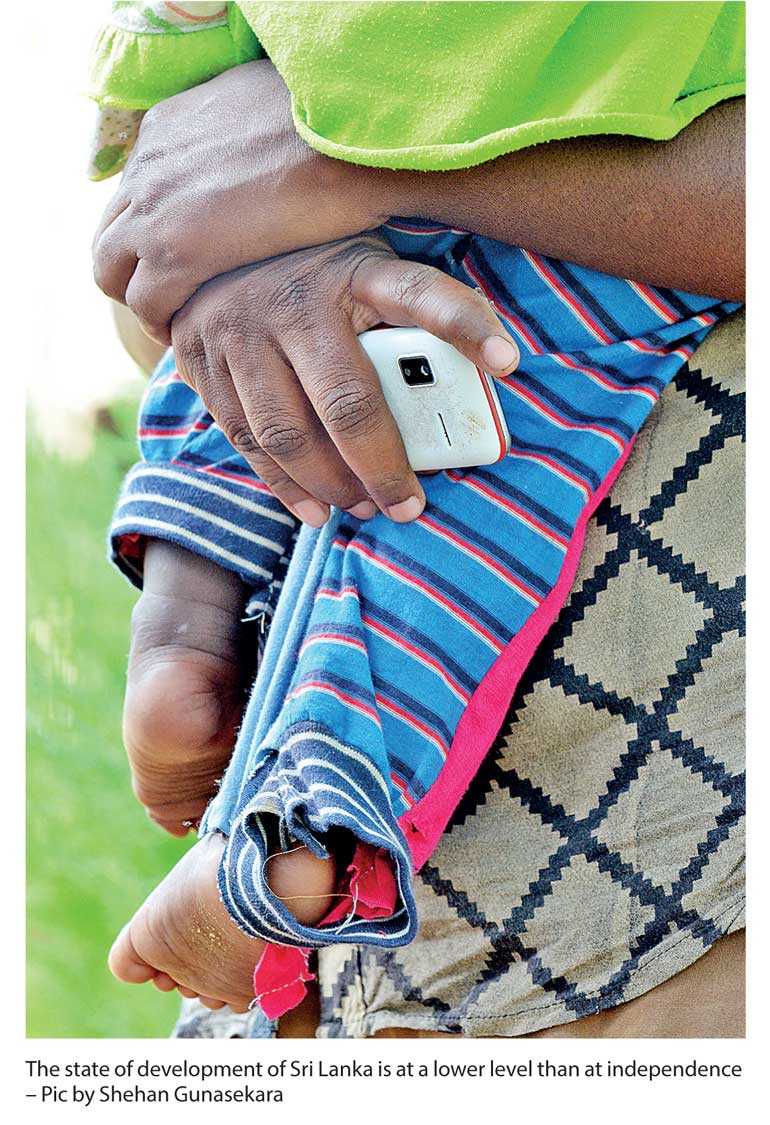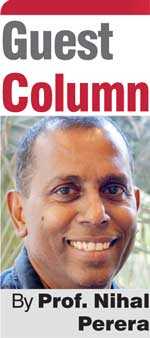Thursday Nov 27, 2025
Thursday Nov 27, 2025
Friday, 18 May 2018 00:00 - - {{hitsCtrl.values.hits}}

 Kandy was not captured by the British but was gifted. The state of development of Sri Lanka too, as these articles demonstrate, is largely locally constructed. According to the development paradigm institutionalised within the US-led world order, economic growth is the means to achieving a high quality of life.
Kandy was not captured by the British but was gifted. The state of development of Sri Lanka too, as these articles demonstrate, is largely locally constructed. According to the development paradigm institutionalised within the US-led world order, economic growth is the means to achieving a high quality of life.
Despite the low GDP, Sri Lanka and Kerala had high social indicators such as life expectancy and literacy and a smaller gap between the rich and the poor. This is reconfirmed by Amartya Sen in his 1999 work which earned him a Nobel Prize. The state of Ceylon’s development at independence in 1948 is said to have been envied by the leaders of Singapore and Korea. For the British, Ceylon was a model post-colony and angel of democracy.
At independence, the national leaders had the option of pulling the nation out of some dependent economic structures constructed under colonialism. What the leaders and experts saw was a development deficit, i.e., something lacking called development – the citizen sought to work hard and make sacrifices to overcome this. The leaders reproduced colonial subjectivity and dependency within the world-economy restructured under the US hegemony. Instead of building on Ceylonese strengths, they fitted the nation within the borrowed concept: underdeveloped. All three instances of squandering development opportunities indicate this blindness of both politicians and experts.
In order to achieve the “development” the West had, the nation needs capital, technology, and the knowhow. The only source of these is core countries. In this model; Sri Lanka has to depend on the West for both resources and knowledge; the State is not only poor but also deficient and dependent.
Despite the push for industrialisation, especially by the Sama Samajists, and the somewhat positive responses by SLFP-led governments, the post-colonial state was unable to transform the economy in ways that would improve capital accumulation within the nation. This way, the national leaders squandered an opportunity to change the nation’s state of development.
First, the dominant notion of development is a universalisation of the specific history of the West. As presented in Walt Rostow’s Non-Communist Manifesto, all nations traverse a natural historical path propelled by an industrial revolution. The Western history is unrepeatable: development critic Gunder Frank demonstrates that countries do not develop independently, but, as they do, they under-develop others.
Second, the Western “societies” that staged industrial revolutions were not nation states; they were imperial metropoles that had vast colonies to exploit and to draw raw materials and other resources. Sri Lanka does not have this luxury.
Third, it is impossible to catch up with Western states as they are also changing, making whatever they do new, such as the service economy and information technology, the new targets. Most Western states are now post-industrial, consumerist, and a large number of cities are deindustrialised, declined, and distressed. This is not what Sri Lanka claims to follow. Despite the obscurity, the development “ideal” set under colonialism still persists. It is confusion at best.
Fourth, the development discourse camouflages the underdevelopment caused by the West, making the states in the periphery believe that they lag behind because of their own history. This makes the core states benevolent providers and the underdeveloped states passive recipients of development aid and knowledge.
Fifth, development projects are profitable to the providers, whether the West or China, and aid and loans come with conditions. The Third World is integral to the West’s (now also China’s) existence.
Sixth, the transfer of knowledge, technology, and equipment is also political; they not only come with strings attached, but also in ideological wrappers, bearing the worldviews of the West where the discourse was produced. In this context, the Westernised experts not only work hard for the underdevelopment of their own nations, but also develop a disability to identify and appreciate local strengths and the weaknesses of the world-economy.
Seventh, it is impossible to implement a foreign idea. Almost all foreign ideas change when they cross cultural boundaries. Even those who volunteer to become subjects transform imposed subjectivities. States too define what development means to them.
Eighth, the model is flawed and has failed. Political-economists have long highlighted the lack of redistribution of resources. Although the goal is to achieve a higher quality of life for people, Amartya Sen highlights the focus on economic growth has privileged the means (money) over higher quality of life. As social values are subjected to economic calculations, making improvements in people’s lives has become a daunting task.
Ninth, as development projects are not grounded, the development knowledge and discourse are easily manipulated by politicians, businesses, and experts. Hence, they benefit a small group, particularly for commissions, bribes, perks, and favours for politicians and high paying jobs, consultancies, and foreign trips for experts.
In sum, the practice of this flawed model has constructed a dominant-dependent relationship between the Western states (now includes proxies) and other nations. It has been good business for the growth machine based in the West and the participants in the periphery, especially the politicians, economists, development specialists, policymakers, and planners. The continued underdevelopment of peripheral states cannot be done from outside without their support.
In Sri Lanka, from Gamini Dissanayake to Mahinda Rajapaksa, politicians favoured mega projects, especially massive spectacles. They transformed development projects into business ventures and personal capital. They have impoverished Sri Lanka, particularly within the context of the world-economy.
There are more poor people in Sri Lanka today than at independence. Half of Colombo’s population lives in underserved settlements and the majority lives on 20% of the municipal land. Gains in education and health are nominal: Parents hardly believe that their children’s educational needs can be met within the school system. The extant political-economy has devalued college education, especially the acquiring of critical knowledge. Every child of parents who could afford tuition classes attend them. Also, most patients do not believe that they can get good healthcare at Government hospitals; they use private channelling services. Most alarming is the suicide rate: Sri Lanka is number one in the world.
In sum, the state of development of Sri Lanka is at a lower level than at independence; declined most clearly from the late-1970s. The Megapolis and the Port City continue this same model.
[Professor Nihal Perera is Chair of the Department of Urban Development at Ball State University, IN, USA and the founding director of CapAsia, one of the best immersive learning programs in the USA. The two-time Fulbright Scholar (China, Myanmar) was also Senior Research Fellow at the National University of Singapore and Melting Pot Fellow at KMITL, Thailand. He was the Chief Architect-Planner of the Mahaweli Project (1983-89); his team built 12 new towns employing a locally-developed planning method. He is also the author of “Decolonizing Ceylon” which introduced the study of social space and politics of space to Sri Lanka followed by two other books based on his research in Asia: Transforming Asian Cities (Routledge, 2013) and People’s Spaces (Routledge, 2015), and a special issue of Bhumi on development (2016).]